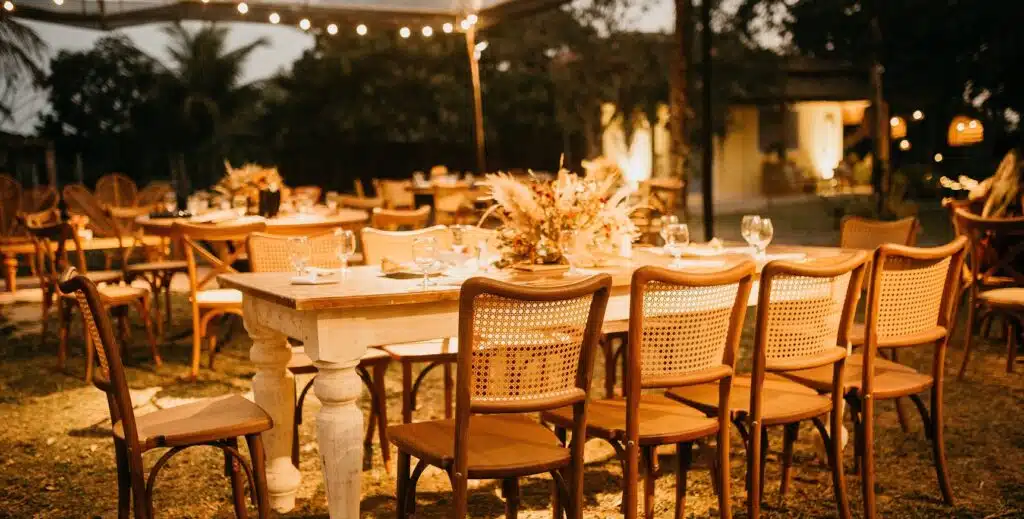To create a great outdoor space or make your home look its best, you need the right residential outdoor lighting. Outdoor lights create ambiance, define spaces, and highlight the best features of your house and landscaping. Here are some smart moves you can make to upgrade the lighting you already have, or make sure you get the best lighting systems for your home.
Smart Move 1: Upgrade to LED
If you have an older outdoor lighting system, or even just a few fixtures on your house (such as motion-sensor lights or porch lights), it’s time to check what type of bulbs you’re using. If you are still using old-style, incandescent bulbs, do yourself a favor: upgrade to LED bulbs. There are two styles of LED bulbs: the drop-in style, and an integrated style. With an integrated LED, the bulb itself is built into the light fixture. If you replace an entire fixture, you might choose an integrated style. However, if you want to keep your current fixtures but upgrade to LED bulbs, you can use the drop-in style. They’re designed to simply and easily replace the old bulbs and screw into your current fixtures.
With LED bulbs, you get the same amount of light for a much lower energy cost. In fact, LEDs operate at 80% less energy consumption than standard incandescent bulbs. Not only does this save on your energy bill, it also allows you to expand your residential outdoor lighting system without overloading your transformer.
Smart Move 2: Use the Right Output
You don’t need the same light output for every outdoor lighting fixture in your yard or around your home. It depends on what each fixture is supposed to do. There are a few things to take into account: how high the light needs to reach, how much area you want it to cover, and how wide, or narrow, the beam of light is. If you want to illuminate a low wall in front of your house, you don’t need as much light output as you would need to spotlight that 20-foot tree in the front yard. Using a bulb with too much output not only wastes energy, but also creates a light that doesn’t look the way you want:
- Too little light output creates odd shapes and shadows.
- Too much light creates glare and odd contrasts.
In both cases, the result is an unprofessional look that does not achieve the uniformity needed for a perfect wash of light across your home and landscaping.
Smart Move 3: Install Matching Fixtures
If you want a quick way to upgrade the appearance of your entire home, here it is: install residential outdoor lighting fixtures that match, and that coordinate with the style and color scheme of your house. It’s an immediate boost in the overall feel and appearance.
Consider your landscaping, shutters and trim color, and the style of architecture. A modern home with black shutters, for example, could be complemented by sleek, black fixtures made of marine-grade aluminum. Do you want pathway lights to blend into the landscape mulching? Choose a slim style in a brown finish. Or do you want them to stand out as their own feature? In that case, choose a more ornate style in a finish that complements the trim on your home. For a high-end look, solid brass fixtures are both striking and classic. It’s all about the impression you want to create and the way the fixtures work with the style of your home.
Smart Move 4: Plan for the Future
With residential outdoor lighting, you have options that can make future upgrades easy. You also have options that can end up wasting your money and causing a lot of frustration. Whether you are upgrading your current system, or having a new one installed, here are some things to consider:
- Will the landscaping change significantly? For example, if you’re installing a spotlight on a newly planted tree, you only need to light up 10 feet of tree. But in a few years, as the tree grows, that amount of light will no longer be enough to do the job. Either the top half of the tree will be in shadow, or you will have to upgrade the lighting. Some fixtures have built-in options to allow for increased lighting output as needed, with an adjustment. For a fixture with a drop-in bulb, you can change the bulb. What you don’t want is to be locked into a certain type of fixture that won’t easily adjust to significant changes in your landscaping.
- Will you add on more lighting fixtures and areas? In many cases, homeowners start with residential outdoor lighting around one or two areas in the yard, or with uplights on the home. Then, later, they might add more lighting: lights on the deck stairs and railing, or pathway lights, bistro lights over an outdoor dining area, or lights to create poolside ambiance. If you’ll want to add more fixtures or areas to your lighting system, make sure you install a transformer that is adequate not only for the lighting you have now, but for the energy load you might want to add in the future.
- Will the lighting last more than a year? It’s easy to get caught up in the newest seasonal offer for solar lights or a DIY lighting kit. The question to consider is how long these lights will last. If you only want them for a season, then a plug-and-play, lower-quality system might be fine. But if you want to invest in residential outdoor lights that will last through the seasons, you need contractor-grade fixtures with guarantees, and professional wiring and connectors that won’t corrode after one St. Louis winter.
Every home is different, and every residential outdoor lighting system should reflect exactly what the homeowner wants. We love working with our customers to design the perfect system and helping you highlight all the best features of your home. Get in touch for a free estimate from the best residential outdoor lighting company in St. Louis.




